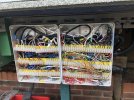Greg,
Let me work through this in detail.
Andrew, you stated the key idea, but I think you did not grasp the way voltage and current compliment each other.
You start your answer by calling out a supposed personal failing of the questioner. Regardless of its accuracy, this puts a negative spin on everything that follows.
Now, obviously I don't understand
something or I wouldn't be asking the question, but for the sake of charity assume that I'm radically simplifying the problem or a little unclear on terminology rather than generally ignorant.
The reason your house runs at 240v instead of 24v is that for the same POWER, the 24v system would have to carry TEN TIMES the current.
...
Bottom line, when running at lower voltages you must be much more "on guard" of voltage drops and wire size, since smaller wire will have more voltage drop too.
This is all well and good, but it's also all background. I know they are factors to consider, what I don't know is
how to consider them.
It all makes sense if you work out voltage losses from thin wire and resistance of connections.
So after all that, you're about to tell me how to apply it to the problem at hand, right? Or at least give an example to justify whether the DCC Wiki values are sensible - which would allow me to compare my situation to theirs and make a judgement call?
Apparently not.
As the topper, you have not given enough information for me to give you an answer of any quality. (how many trains at once, measured current draw, track voltage, type of rail joiners, method of attaching wires to each other and the rails, etc.)
Yes, my question is missing information. But then, so is the DCC wiki article I referenced.
That said, there's more than enough information to provide some useful starting points.
Example: I specify 24v / 6A and 10m. And provided for comparison 2.5mm housing wire. Some suggested answers:
- "If you run a DCC signal through 10m of 2.5mm wire, you will lose (?) volts (show calculation). In contrast, if you use 10m of (?), you will only lose (?) volts"
- "I use wire (?) for my runs at home, which are (?)m long and carry 24v/(?)A. Loss is at most (?)v."
Pushing further:
viaEstrecha says that he uses 1mm cross-section auto wire, which if I've understood correctly will work out to about 0.78mm2 (0.5^2 * pi). This is substantially less than 6-10mm2.
In contrast, Rhinochugger does use 6mm2, which is consistent with the DDC wiki guidelines.
Meanwhile, I've been using a 5m run of
LGB 51235 hook up wire (about 20 AWG) to run from the Command Station to my track, and then primarily using just the track to distribute DCC around ~82m of LGB track (longest distance from junction point about 10m). Joins are a mix of standard fishplates, fishplates with graphite paste, and Massoth rail joiners. Haven't had any problems obviously related to power distribution. Locos are 3x LGB from around 2000 - 2x 2-axle starter locos and a 28002 0-8-0 Rugen. I've been trying to get my hands on an RRAmpMeter IV but I haven't found an Australian distributor.
Even more out of character, instead of wanting the details of how and why, you just want the answer.
No, but I do want
an answer I can work from.
Generally, every time I ask a question I'm asking two questions.
- How do I apply this to a specific example that I'm thinking of? This might be something I'm currently doing or something I'm thinking about doing in the future.
- How do I generalise this to a class of problems?
In this case, I have a problem where my programming and service area is
inside the house but my layout is outside. At present, this means physically moving the command station around when I want to service / run trains. Command station is a z21 connected to my home wi-fi, so I don't need physical connection to the command station to run trains, but I need the connection to the track.
The inside location is close enough to the yard that I'm with a few metres of one extreme end of the layout, so I plan to leave the command station indoors and run a patch lead out to the railroad. However, I wanted a better run to somewhere in the middle (where most of the track and accessories are) rather than just to one end. Thus the 10m figure and trying to decide what quality of wire I need to run for the main bus. While I was at it, I was thinking about running some additional taps.
While trying to spec this all out, I realised that the 8-10 AWG wire suggested by the DCC Wiki is
very big compared to most other household or electrical wire, and even
bigger compared to the wire I was already running. I was more concerned about signal corruption than power loss, although am aware both are factors on long runs.
I also wanted things set up so I could replace the long run with a booster in the future, if appropriate.
Also looking for advice about feeder wire taps. Assuming a single supply point (and ignoring considerations of control / detection / reversing loops), is there value in dividing the track into insulated power sections, or is it OK to have (electrically speaking) entire loops of rail with multiple taps from the feeder bus? Is there a maximum / minimum number of taps for reliable operation?
Despite having 3 loops with sidings, the layout is currently just two "rails" with a single tap. While re-doing other wiring, I'm happy to restructure this as required.




